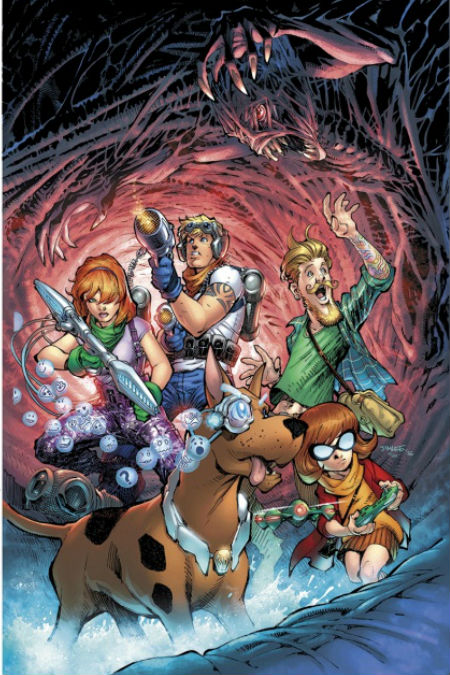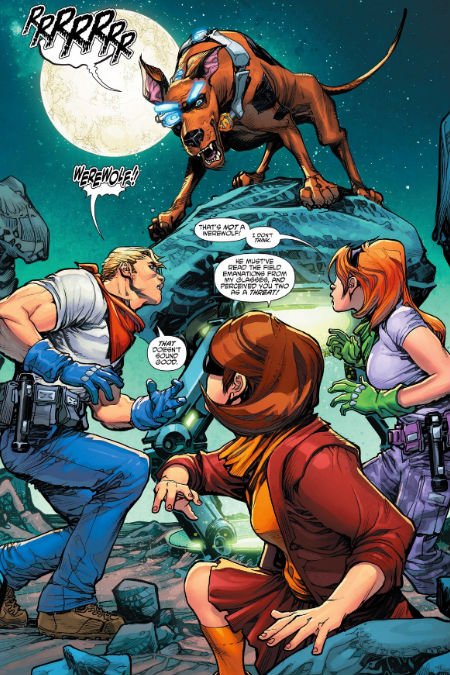
Something tells me that the newly-ruined earth in which the just-united Scooby gang emerge in this considerably darker take on the perennial Hanna-Barbera favourite is not going to be easily-righted by the end of one their franchise’s normally light-and-airy “And I would’ve gotten away with it too if it wasn’t for you meddling kids” episodes.
This is a real apocalypse, the kind of everything is wrecked and your survival is not guaranteed scenario so beloved of franchises like The Walking Dead, Z Nation and 12 Monkeys.
There’s not even a hint of a disgruntled former employee who wants to ruin the redevelopment of the fun fair that was once their life, or of an angry disinherited scion of a wealthy family who’s determined to put the Haunted back in haunted house, capitalised letter H and all.
No, this is a world into which the four cohorts of Dr Velma Dinkley, who operate from a suspiciously hidden, superbly equip laboratory complex deep underground, have released an army of eager to mutate nanites whose idealistic job, at least it was initially, is to rewire humanity so they’re docile, pacifistic dolts.
The end result was supposed to be a worldwide population of well-behaved village morons who wouldn’t raise a warlike figure to their neighbour and would presumably sup on tea and talk about scones and knitting to their equally-happy neighbours till their dying day.
But alike the best plans of mice and men – seriously someone has to stop letting rodents plan things; it always ends in tiny mice-like tears – things have gone awry and what the world gets instead is a nightmarish transformation of pretty much everyone into the kinds of freakish, flesh-hungry monsters that Scooby, an experimental dog who failed his training, and his handler Shaggy, would run from in an instant. (Think the movie Serenity, which wrapped up the much-loved Firefly series.)
Battling this hideous monster mash, with nary a bad mask or slipshod CGI projection to be seen, is Velma, who is in the process of blowing the whistle to onetime highflying reporter and host of a subpar mysteries show on the Knitting Channel Daphne and her college friend/sweetheart (from his side only alas), Fred.
Throw in Scooby and Shaggy, who along with the others are spared the mutating effects of the Nanites by virtue of being in the complex’s Safe Zone when things go royally and quite unplayfully to crap in a major way, and you have the gang we know and love, well apocalyptic iterations thereof anyway, together and ready to right a once-well intentioned scientific gone horribly, and perhaps deliberately, wrong.

Doesn’t sound much like your grandma’s Scooby Doo now does it?
And of course it isn’t, given that Scooby Apocalypse – the “Doo” presumably got lost somewhere in the march to gritty darkness and end of the world despair – is part of DC Comics much-ballyhooed revamp/reimagining/rebooting of a number of Hanna-Barbera properties including Wacky Races (now Wacky Raceland) and The Flintstones.
As a story in and of itself, it’s actually pretty cool, giving us all the world-gone-to-s**t vibe that any apocalypse show worth its salt should have in spades. While we’re not sure in the first three issues if Scooby and the gang are the only unmutated survivors of this beastial attempt at societal conditioning, it’s strongly suggested that Velma’s colleagues are pulling the puppet strings from somewhere nearby.
We’re also given an assurance of sorts that this experiment gone awry might be reversible but this and many other “what ifs?” are left to blow into the wind as everyone simply tries to survive the onslaught of nasty, freakish brutish beasts, some of whom can speak and some cannot.
The question is of course is this really Scooby Doo?
Well it’s not meant to be classic Scooby Doo, a franchise that has gone through more iterations down through the years – the less said about Scrappy Doo the better thank you very much – and it’s not just the lack of the “Doo” in the title that gives that game away.
The gang are visually and character-wise completely badass versions of themselves and while Velma is still the knowledgeable geek and Scooby and Shabby still adorably devoted to each other, not much else of the warm bonhomie between the dedicated mystery solvers remains.
Now whether this is an issue depends greatly on how you view Scooby Doo as a whole. If like many people, including yours truly, the loss of the somewhat irritable but always devoted bonds between the gang and their propensity for goofiness feels strangely deficient.
If however you like your characters dark, their relationships dark, troubled and twisted and your monsters of the flesh-tearing rather than homemade mask-wearing variety then you will likely lap this series up.
As noted, as an apocalyptic series judged on its own merits its beautifully and tautly written with impressive world building by Keith Giffen and J.M. DeMatteis with suitably full-on, vividly colourful art by Howard Porter.
As a reimagined take on Scooby Doo? Possibly less successful. Too much of what made Scooby Doo and his human mystery solvers such a goofy delight to watch is lost, and with it much of the connection to the characters.
Do I want to see how this all ends? Absolutely, it’s that well-conceived and executed with all the tension and narrative momentum you could for. But as another entry in Scooby’s long and varied annals? Not so much and I wonder how many fans will last the distance in this new dark and thoroughly unfunny take on the tenacious denizens of the Mystery Machine.